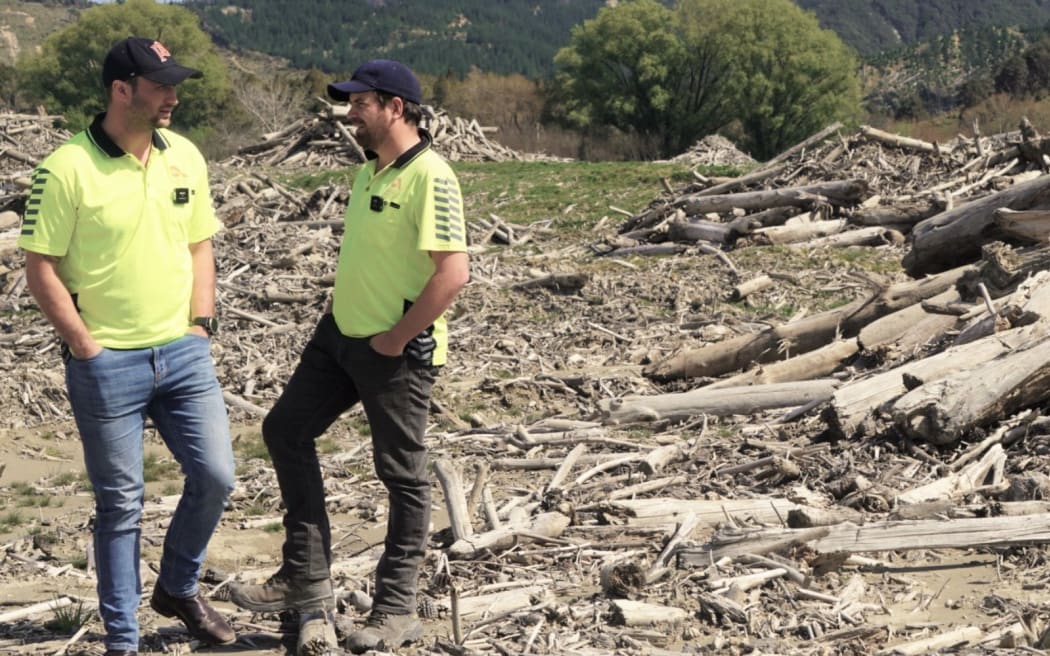
Aratu's tree crop manager Willy Grogan, left, and cyclone recovery manager Rich Powell, right, standing amid the windrows of slash on Paroa Station. Photo: RNZ / Kate Green
The multimillion-dollar slash clean-up on the East Coast drags on, with forestry companies spending their own money and resources to get back in the community's good books.
Heavy rain during Cyclone Hale in January, quickly followed by Gabrielle in February, pushed hundreds of thousands of logs down rivers, causing widespread flooding and damage.
Some of the region's forestry companies were out there cleaning up, but residents said others were ducking for cover.
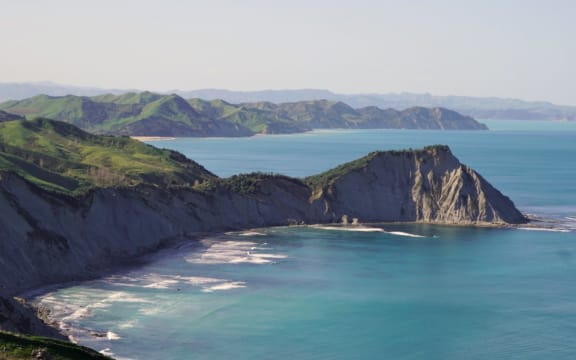
The view from Aratu's Kopua block, where a series of waahi tapu, sacred pa sites, sit overlooking the sea. Photo: RNZ / Kate Green
The industry was under pressure, after a government-commissioned report recommended sweeping changes to forestry practices - but in the absence of meaningful legislative change, the onus fell on forestry companies themselves to make changes for the good of the community and the natural environment.
Paroa Station was one of many to be inundated with floodwater, silt and slash during Cyclone Gabrielle.
Farm manager Brenden Ewart said in the aftermath, he saw more help from some companies than others.
"I've predominantly dealt with Aratu and Ernslaw," he said. "They've been good to deal with - there's been a few others that are trying to hide."
Lack of legislative change
The government has been criticised for doing too little, too late to hold forestry companies to account.
An announcement from Forestry Minister Peeni Henare was met with a mixture of disappointment and outrage by locals, with some members of the public storming out of the meeting at the minister's assertion that native bush regeneration was not the silver bullet the region was looking for to prevent erosion and woody debris.
Rather than announcing law changes, as many in the community had hoped for, the government presented a plan which included an immediate ramping up of efforts to clear woody debris and two new job positions dedicated to community engagement.
It said the regulation changes would come later, wrapped into work already underway, such as the reworking of the Resource Management Act (RMA) and the National Policy Statement on Plantation Forestry (NPS-PF).
It also announced more support for Gisborne District Council on land use management.
Previously, the council had only two dedicated forestry compliance officers for "business as usual activities", supported by a wider team of six compliance officers, and two investigators.
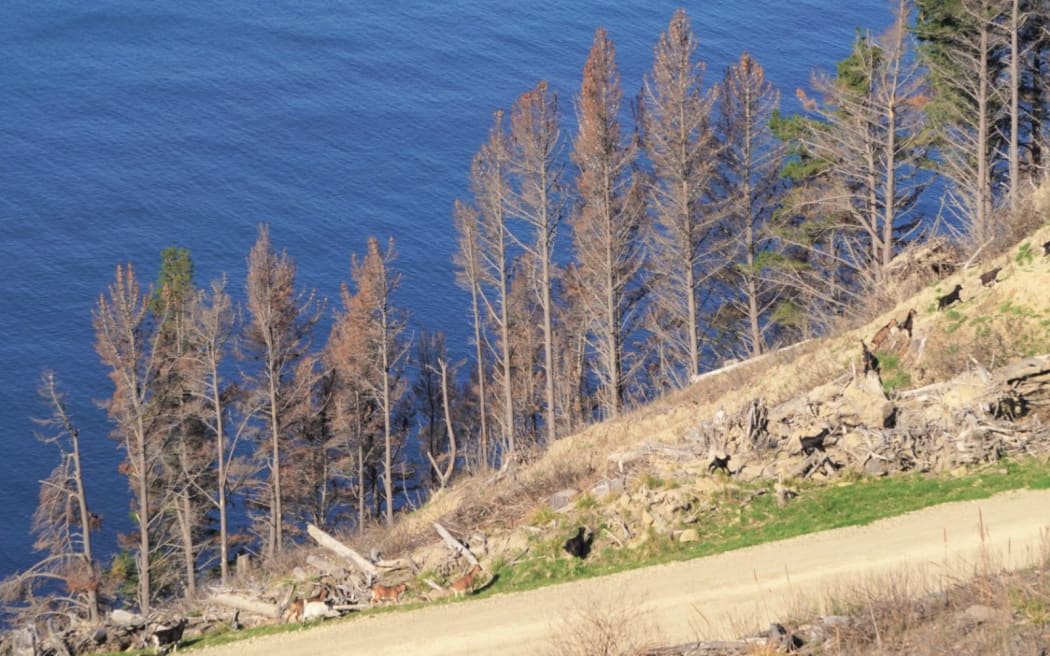
These trees are being killed off so the block, which is very difficult to harvest because of the steep slope, can be retired. Photo: RNZ / Kate Green
Earlier this month, it said it was in the process of recruiting a dedicated forestry compliance and monitoring team of five off the back of the report.
Ewart said it would be good for the government and council to be able to better hold companies to account.
Green Party forestry spokesperson Eugenie Sage said landowners should not rely on the industry doing this voluntarily, and there should be a levy on the industry to fund slash clean-up.
"We need much stronger controls," she said. "We need the industry to come to the party with the removal of the slash and the clean-up."

Eugenie Sage. Photo: RNZ / Simon Rogers
ACT forestry spokesperson Mark Cameron agreed it should be on the polluter to pay.
"If what you do on your private land affects your neighbour... or if you're a polluter into the commons, beyond a certain discharge limit, there is a threshold at which you would be liable."
So far, the Labour government had dedicated more than $10 million to removing 70,000 tonnes of woody debris, and a portion of the $70m for clean-up on commercial properties will be spent on slash removal.

Thousand of tonnes of logs washed down from forestry blocks, and now companies like Aratu are helping to clean up the mess. Photo: RNZ / Kate Green
Cleaning up
Aratu Forests was one company with forestry blocks upstream of Paroa Station - and while it was hard to know exactly whose slash was whose, Aratu stepped in to help with the clean-up.
Chief executive Neil Woods said they had spent $2.8m on clean-up so far, and it would be more than $3m by the time they were done.
Another of the big players, Ernslaw One, said it had spent about $1.6m on out-of-forest clean-up, on top of a donation of $500,000 to the Tai Rāwhiti Mayoral Relief Fund.
One particular spot on Paroa Station had acted as a natural slash catcher, with 3.5 hectares of flat land now totally covered in a tangle of logs, pulled into windrows by Aratu contractors to be burned.
Aratu cyclone recovery manager Rich Powell said the goal was to have multiple catch points like this further upstream, to catch the debris before it made its way onto private land.
"Your intention is not to have material migrate from your forest, however there needs to be an acceptance that it's likely to happen, regardless of practices."
Not all of the woody debris came from forestry. A good part of it was, he said, but whole trees, even natives, were broken and washed downstream in the severe weather outside of their forestry blocks.
"We've seen what's come out of smaller mānuka blocks, even silt - we have to be realistic," Powell said.
Despite not all of it being their mess, Powell said they were still best placed to clean it up thanks to their machines and trained crews who, due to a coincidental market downturn, were looking for work anyway.
"We're doing it because it's the right thing to do."
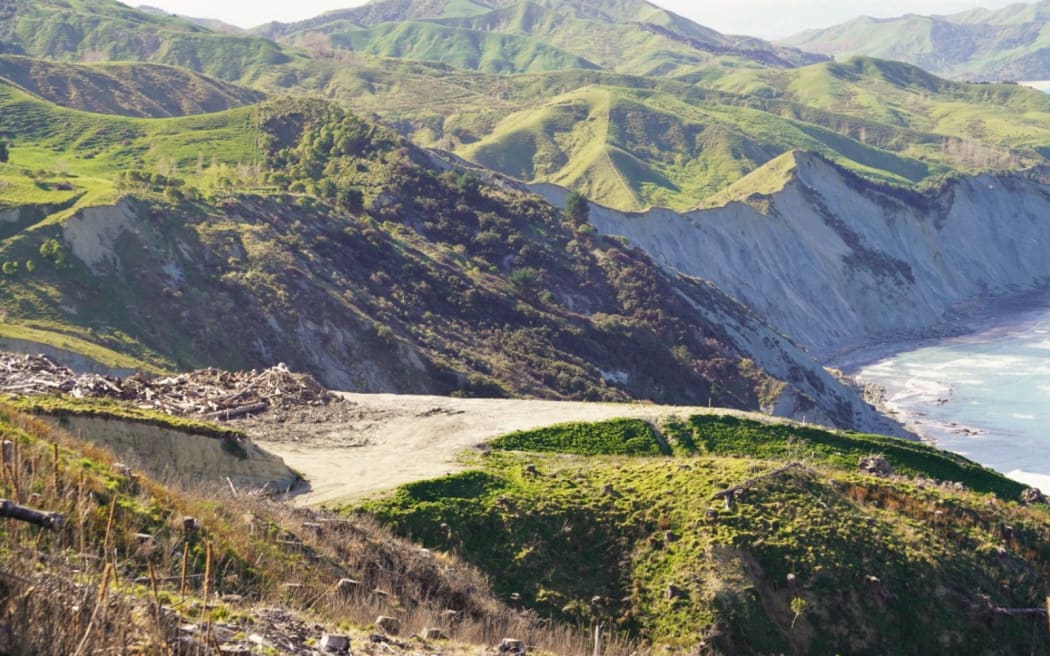
Piles of logs are now stored metres back from the edges of hillsides to prevent them being washed away in bad weather. Photo: RNZ / Kate Green
Making changes
Aratu tree crop manager Willy Grogan said the industry knew it had to change, and it was doing so already.
Planting blocks of natives, or trees with different growth cycles to the main forest, around the edges created natural slash catchers between main roads and waterways.
Standing on a hillside south of Gisborne, in Kopua forest, Grogan pointed out a block of newly planted redwoods on the outskirts of a pine block.
"They get harvested at a different time, because their rotation is a lot longer," he said. "That's going to act as a natural buffer for when we harvest that other side next time."
It had dual benefits, including reducing the 'edge effect' - when trees on the edges of forests grew gangly and unwieldy as they branched outwards, lowering the quality of the wood.
A buffer zone between forests and roads also reduced the need for traffic control, which was not cheap - a win for the company's bottom line, too.
Grogan said things had been slowly changing for years, with more mindful planting and management practices beginning after a bout of severe weather in 2018.
These days, forestry roads were built to higher standards, and leftover wood was stacked further back from the edges of slopes at skid sites to reduce the risk of it being washed into waterways.
Other companies were making similar changes.
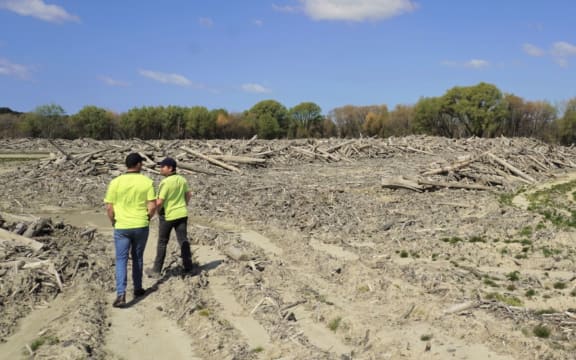
In one part of Paroa Station, three and a half hectares of slash and silt piled up during Cyclone Gabrielle. Photo: RNZ / Kate Green
Ernslaw said it was looking for alternative uses for this material, as removing woody debris from harvesting sites to make biofuel would be beneficial for the local economy and the environment.
Regional manager Blair van der Maas said they were committed to improving practices to make their forests more resilient and contained, and "we look forward to embracing the opportunities to explore the biomass options".
Following Gabrielle, it remapped its forests to pinpoint future locations for debris traps, and used a new spatial technology to help in harvest planning to identify potential landslides.
Relationships with local iwi
About a five-minute drive up a forestry road from the newly planted redwoods, Grogan pointed out a handful of waahi tapu, sacred sites, which sat within Aratu's forest.
The area around these was being transitioned back to native bush, and a walkway put in, with any potentially precious objects unearthed by contractors given back to the iwi.
Jody Toroa, a trustee of Rangiwaho Marae which sits at the south end of the Kopua forest block, said it was a good start - and she knew Aratu's chief executive still had to balance a bottom line.
"Where we want to be isn't where they are, so we've got to keep working on the relationship," she said. "So he's hearing how important the waterways are, riparian planting, he's got a view of that because he's got a financial model, he's got a business model - you know, we're realistic."
Forestry companies were demonstrating their social conscience in other ways - cleaning pollen off the marae's solar panels, and coming to meetings with iwi.
But she would like to see all steep gullies retired from forestry, and replanted in native bush to prevent erosion and catch woody debris before it ended up in their rivers.
Retiring forestry land
The Ministerial Inquiry into Land Use recommended large areas of forest be retired completely. Aratu and Ernslaw both said they were considering which areas to retire.
But Aratu's Neil Woods said retiring existing forests would not always solve the problem.
It was a case of being left with "legacy problems" - those which were set in motion decades ago, and were only now making themselves known as the weather grew more severe.
Woods said forests planted 30 years ago, which were now proving to be inappropriate for the area, could not just be left to grow.
In some cases, large pines grew too heavy for the slopes they stood on, causing slips in wet weather, and would need to be harvested and replanted with bush - or in some cases left bare, to prevent it.
Changes could be made when it came time to harvest, but for some blocks, that was decades away.


